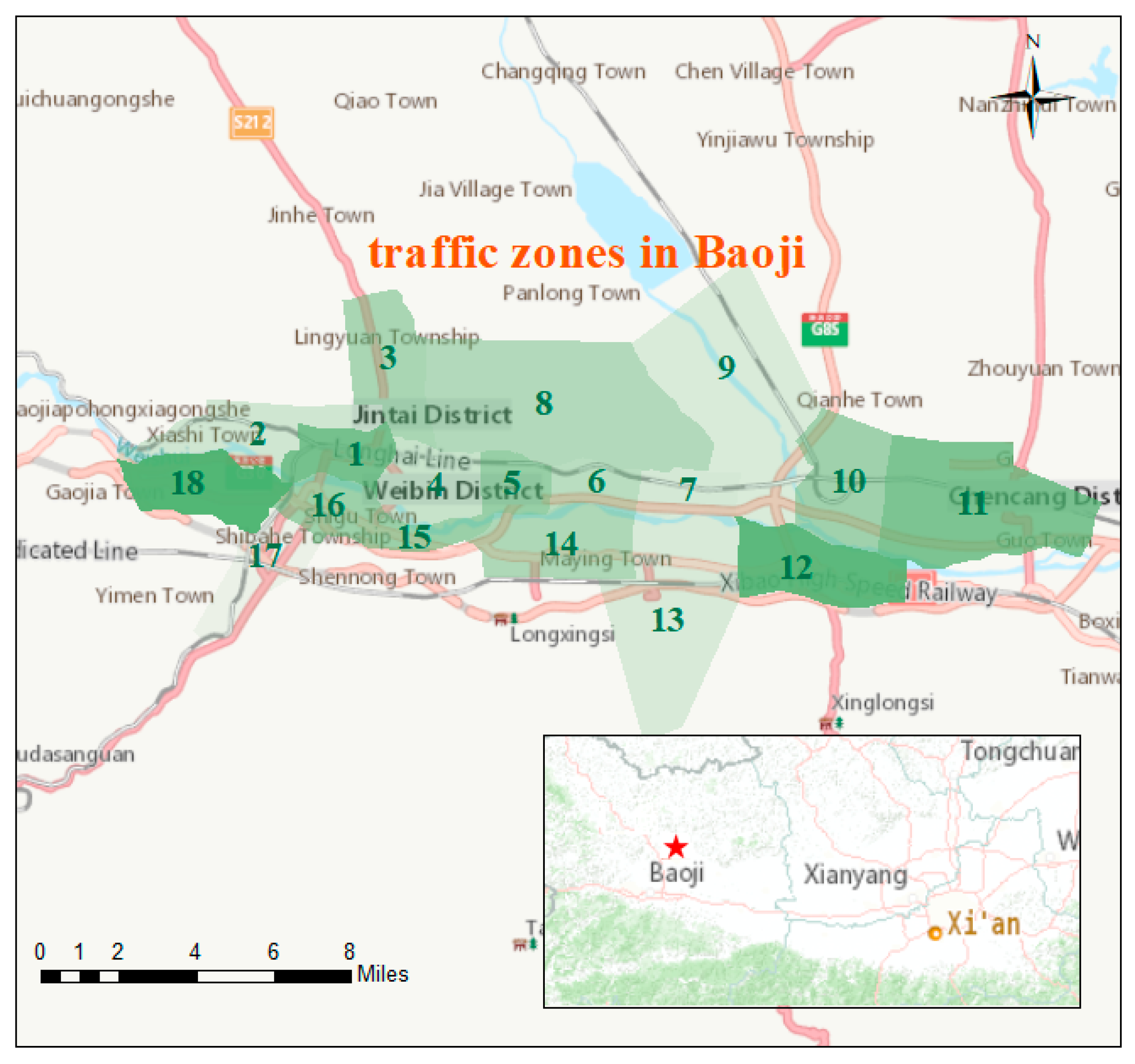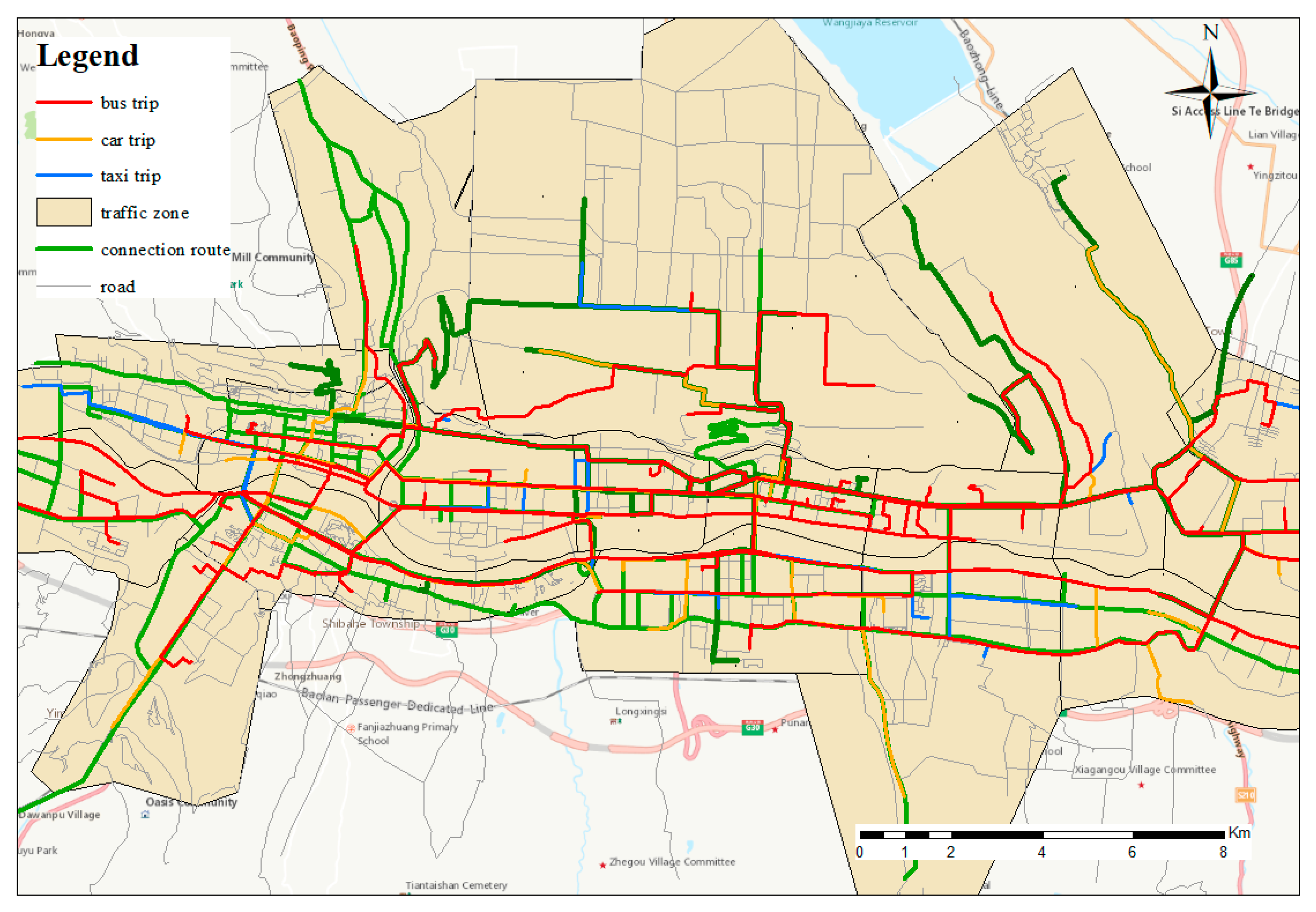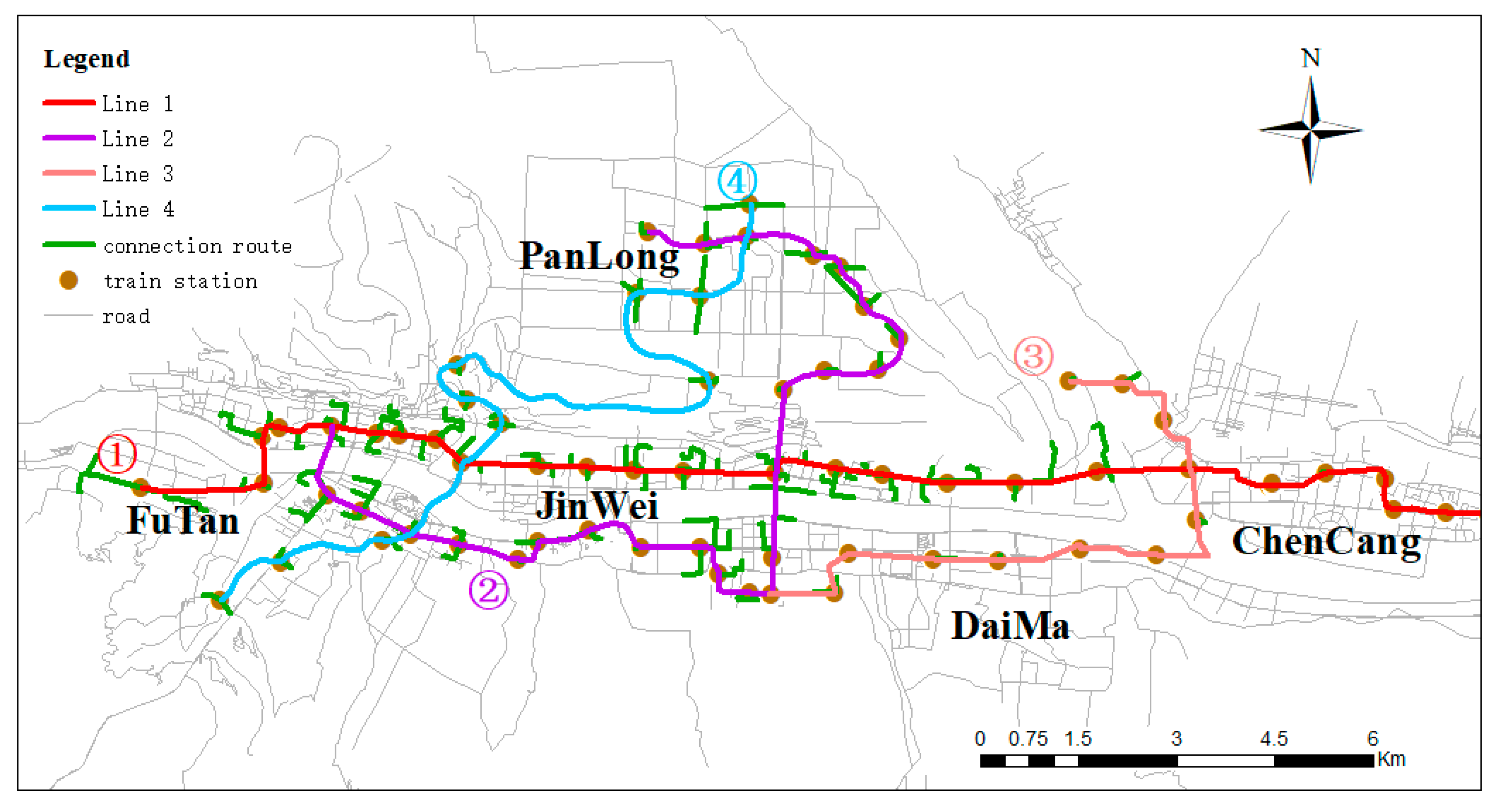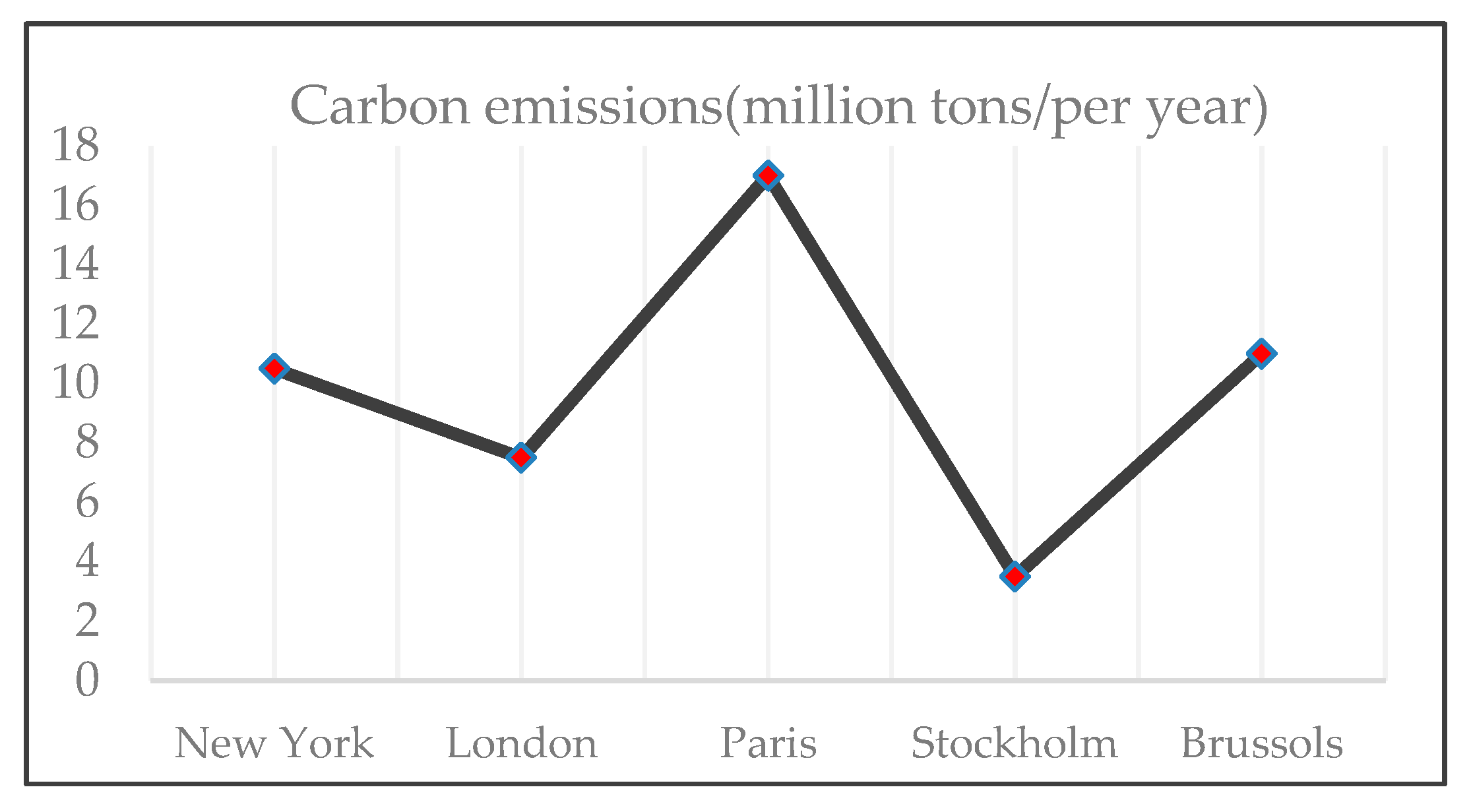Low-Carbon Impact of Urban Rail Transit Based on Passenger Demand Forecast in Baoji
Abstract
:1. Introduction
2. Data Availability and Research Scope
2.1. Data Availability Analysis
2.2. Calculation Scope Description
3. Methodology and Data Gathering
3.1. The Basic Principles of the Mixed Logit Model based on the Choice of Residents’ Travel Mode
3.2. Individual Trips Distance Calculation
3.3. Calculation Model for Urban Rail Carbon Emission Reduction
3.3.1. Scenario 1. The scenario without Urban Rail Transit
3.3.2. Scenario 2. The scenario with Urban Rail Transit
4. Results and Discussion
4.1. Division of Travel Mode Sharing Rate
4.2. Calculation of Rail Transit Carbon Emissions Reduction
5. Conclusions
Author Contributions
Funding
Conflicts of Interest
References
- Jiang, H.; Bai, F. Research on low carbon economy evaluation of Urban Rail Transit. Railw. Transp. Econ. 2010, 32, 11–15. [Google Scholar]
- Li, X.; Yu, B.Y. Peaking CO2 Emissions for China’s Urban Passenger Transport Sector. Energy Policy 2019, 10, 1–18. [Google Scholar] [CrossRef]
- Pucher, J.; Peng, Z.R.; Mittal, N.; Zhu, Y.; Korattyswaroopam, N. Urban Transport Trends and Policies in China and India: Impacts of Rapid Economic Growth. Transp. Rev. 2007, 27, 379–410. [Google Scholar] [CrossRef]
- Bao, X.D. Urban Rail Transit Present Situation and Future Development Trends in China: Overall Analysis Based on National Policies and Strategic Plans in 2016–2020. Urban Rail Transit 2018, 4, 1–12. [Google Scholar] [CrossRef] [Green Version]
- Lu, K.; Han, B.M.; Lu, F.; Wang, Z.J. Urban Rail Transit in China: Progress Report and Analysis (2008–2015). Urban Rail Transit 2016, 2, 93–105. [Google Scholar] [CrossRef] [Green Version]
- Yuan, R.Q.; Tao, X.; Yang, X.L. CO2 Emission of Urban Passenger Transportation in China from 2000 to 2014. Adv. Clim. Chang. Res. 2019, 10, 59–67. [Google Scholar] [CrossRef]
- Wang, H.H.; Zeng, W.H. Revealing Urban Carbon Dioxide (CO2 ) Emission Characteristics and Influencing Mechanisms from the Perspective of Commuting. Sustainability 2019, 11, 385. [Google Scholar] [CrossRef] [Green Version]
- Ecola, L.; Zmud, J.; Gu, K.; Phleps, P.; Feige, I. The Future of Mobility: Scenarios for China in 2030. RAND Institute for Mobility Research; Deloite University Press: Santa Monica, CA, USA, 2015. [Google Scholar]
- Xu, W.; Guthrie, A.; Fan, Y.; Li, Y. Transit-Oriented Development: Literature Review and Evaluation of TOD Potential across 50 Chinese Cities. J. Transp. Land Use 2017, 10, 743–762. [Google Scholar] [CrossRef] [Green Version]
- Li, G.Q.; Li, Q.Q.; Zhuang, Y.; Yue, Y.; Liu, Z.Z.; Li, S.Q.; Daniel, S. Urban Commuting Dynamics in Response to Public Transit Upgrades: A Big Data Approach. PLoS ONE 2019, 14, e0223650. [Google Scholar]
- Wu, W.J.; Liang, Y.T.; Wu, D. Evaluating the Impact of China’s Rail Network Expansions on Local Accessibility: A Market Potential Approach. Sustainability 2016, 8, 512. [Google Scholar] [CrossRef] [Green Version]
- Boarnet Marlon, G.; Wang, X.Z.; Douglas, H. Can New Light Rail Reduce Personal Vehicle Carbon Emissions? A Before-After, Experimental-Control Evaluation in Los Angeles. J. Reg. Sci. 2017, 57, 523–539. [Google Scholar] [CrossRef] [Green Version]
- Kwan, S.C.; Tainio, M.; Woodcock, J.; Sutan, R.; Hashim, J.H. The Carbon Savings and Health Co-Benefits from the Introduction of Mass Rapid Transit System in Greater Kuala Lumpur, Malaysia. J. Transp. Health 2017, 6, 187–200. [Google Scholar] [CrossRef]
- Wu, S.M.; Pei, Y.L.; Cheng, G.Z. The study of urban traffic modal splitting method based on MD model under the low-carbon mode. Comput. Model. New Technol. 2014, 18, 197–202. [Google Scholar]
- Wang, Z.J.; Chen, F.; Fujiyama, T. Carbon emission from urban passenger transportation in Beijing. Transp. Res. Part D Transp. Environ. 2015, 41, 217–227. [Google Scholar] [CrossRef]
- Li, L.; Hu, J.; Shao, D. The carbon emission reduction benefits of the rapid development of Shanghai Expo. China Environ. Sci. 2012, 32, 1141–1147. [Google Scholar]
- Board, C.E. Approved Consolidated Baseline and Monitoring Methodology ACM0016—Baseline Methodology for Mass Rapid Transit Projects; UNFCCC: Rio de Janeiro, Brazil; CCNUCC: Rio de Janeiro, Brazil, 2011. [Google Scholar]
- Chen, F.; Shen, X.P.; Wang, Z.J.; Yang, Y. An Evaluation of the Low-Carbon Effects of Urban Rail Based On Mode Shifts. Sustainability 2017, 9, 401. [Google Scholar] [CrossRef] [Green Version]
- Hiroshi, O. Planning of urban rail transit system in Tokyo, Construction and management. Res. Urban Rail Transit 2003, 3, 1–7. (In Japanese) [Google Scholar]
- Li, Z.; Li, C.; Liao, K. Research and Practice of Monitoring and Evaluation on Carbon Emission from Urban Transport; China Communications Press Co., Ltd: Beijing, China, 2017; ISBN 978-7-114-14073-0.201. [Google Scholar]
- Baoji Municipal Commission of Urban and Rural Planning. In Baoji’s Urban Rail Transit Network Construction Plan (2017–2023); Baoji Municipal Government: Baoji, China, 2016.
- Chang’an University. Survey on Comprehensive Transportation and Urban Residents’ Travel in Baoji, 2014 and Supplementary Traffic Survey in 2017; Baoji Municipal People’s Government: Baoji, China, 2017.
- Baoji Transportation Bureau. Baoji Traffic Development Annual Report, 2009–2018; Baoji, China, 2018.
- Baoji Municipal People’s Government Office. Assessment of Energy Saving, Carbon Emission Reduction and Coal Reduction in 2017; Baoji, China, 2017.
- Lin, J.W.; Shen, P.; Lee, B.J. Repetitive model refinement for questionnaire design improvement in the evaluation of working characteristics in construction enterprises. Sustainability 2015, 7, 15179–15193. [Google Scholar] [CrossRef] [Green Version]
- National Development and Reform Commission of China. 2017 Baseline Emission Factors for Regional Power Grids in China; China Statistics Press: Beijing, China, 2017. (In Chinese) [Google Scholar]
- National Bureau of Statistics of China. China Energy Statistical Yearbook 2018; China Statistics Press: Beijing, China, 2019.
- Wang, Z.J.; Chen, F.; Shi, Z. Prediction on medium and long term energy consumption of urban rail transit network in Beijing. China Railw. Sci. 2013, 4, 133–136. [Google Scholar]
- Ma, C.; Wang, Y.; Guo, Y. Sensitivity analysis on urban rail transit passenger flow forecast. In Proceedings of the 2011 International Conference on Electric Technology & Civil Engineering, Lushan, China, 22–24 April 2011. [Google Scholar]
- Wang, S.S.; Huang, W.; Lu, Z.B. Study on Mixed Logit Model and Its Application in Traffic Mode Split. J. Highw. Transp. Res. Dev. 2006, 5, 88–91. (In Chinese) [Google Scholar]
- McFadden, D.; Train, K. Mixed MNL models for discrete response. J. Appl. Econom. 2000, 15, 447–470. [Google Scholar] [CrossRef]
- Li, H.; Huang, H.; Liu, J. Parameter Estimation of the Mixed Logit model and Its Application. J. Transp. Systems Eng. Inf. Technol. 2010, 10, 73–78. [Google Scholar] [CrossRef]
- Wen, C.H.; Koppelman, F.S. The generalized nested logit model. Transp. Res. B 2001, 35, 627–641. [Google Scholar] [CrossRef] [Green Version]
- He, M.; Guo, X.C.; Ran, J.Y. Forecasting Rail Transit Split with Disaggregated MNL Model. J. Transp. Syst. Eng. Inf. Technol. 2010, 10, 136–142. [Google Scholar] [CrossRef]
- Song, X.M.; Jiang, Y.S.; Yun, L. Study on the calculation method of MD forecast model. J. Transp. Eng. Inf. 2010, 2, 65–70. [Google Scholar]
- Baron, T.; Tuchschmid, M.; Martinetti, G.; Pépion, D. High Speed Rail and Sustainability. In Background Report: Methodology and Results of Carbon Footprint Analysis; International Union of Railways (UIC): Paris, France, 2011. [Google Scholar]
- Cuenot, F.; Gabriel, C.H. Carbon Footprint of Railway Infrastructure. Comparing Existing Methodologies on Typical Corridors. Recommendations for Harmonized Approach. 2016. Available online: https://uic.org/IMG/pdf/carbon_footprint_of_railway_infrastructure.pdf (accessed on 12 July 2016).
- Network Rail. Comparing the Environmental Impact of Conventional and High Speed Rail; Milton Keynes, Bucks: London, Britain, 2009. [Google Scholar]
- Olugbenga, O.; Kalyviotis, N.; Saxe, S. Embodied Emissions in Rail Infrastructure: A Critical Literature Review. Environ. Res. Lett. 2019, 14, 123002. [Google Scholar] [CrossRef] [Green Version]
- Egis. Introduction to Greenhouse Gas Emissions in Road Construction and Rehabilitation. 2010. Available online: https://www.google.co.th/url?sa=t&rct=j&q=&esrc=s&source=web&cd=3&cad=rja&uact=8&ved=0ahUKEwi4uu_k9tXKAhWFHY4KHZENDoMQFggtMAI&url=http://siteresources.worldbank.org/INTEAPASTAE/Resources/GHG-ExecSummary.pdf&usg=AFQjCNESVUT_Mx6NmMOUjLHSUo6QXCMo (accessed on 1 November 2010).
- Chang’an University. Research of the Passenger Flow Demand Forecast on Urban Rail Transit Network Planning of Baoji; China Railway Engineering Consultants Group Co., LTD: Beijing, China, May 2017. (In Chinese) [Google Scholar]
- General Administration of Quality Supervision, Inspection and Quarantine of China. Test Methods for Fuel Consumption of CNG Vehicles; GB/T 29125-2012; China Standards Press: Beijing, China, 2012. (In Chinese) [Google Scholar]
- Xia, H.; Li, X. Study on Intensive Design of Urban Rail Transport Hub from the Perspective of Low-Carbon; Springer: Berlin/Heidelberg, Germany, 2012; pp. 409–415. [Google Scholar]
- Baoji Urban Rail Transit Construction Co., Ltd. Study on the environmental impact of Baoji’s Urban Rail Transit Construction Plan (2017–2023); Baoji Urban Rail Transit Construction Co., Ltd. Baoji Municipal Government: Baoji, China, 2017. [Google Scholar]
- Carney, S.; Green, N.; Wood, R.; Read, R. Greenhouse Gas Emissions Inventories for 18 European Regions. 2009. Available online: http://www.euco2.eu/resources/GRIPBroschuere-Small.pdf (accessed on 30 November 2015).
- Ricardo-AEA. Local and Regional CO2 Emissions Estimates for 2005–2011—CO2 Emissions Within the Scope of Influence of Local Authorities (Previously Called National Indicator 186: Per Capita CO2 Emissions in the LA Area), Department of Energy and Climate Change, London. 2013. Available online: https://www.gov.uk/government/uploads/system/uploads/attachment_data/file/212448/Copy_of_Subset_Datatables.xlsx (accessed on 22 January 2013).
- Dickinson, J.; Khan, J.; Amar, M. Inventory of New York City Greenhouse Gas Emissions; City of New York, Mayor’s Office of Long-Term Planning and Sustainability: New York, NY, USA, 2013; Available online: http://nytelecom.vo.llnwd.net/o15/agencies/planyc2030/pdf/greenhousegas_2013.pdf (accessed on 1 April 2007).
- Peng, B.B.; Du, H.B.; Ma, S.F.; Fan, Y.; David, C. Broadstock. Urban passenger transport energy saving and emission reduction potential: A case study for Tianjin, China. Energy Convers. Manag. 2015, 102, 4–16. [Google Scholar] [CrossRef]




| Parameter | Type | Code |
|---|---|---|
| Trip attribute (X) | trip purpose Xpu | commute trip:1; not commute trip:-1; |
| trip original time Xst | commute trip: flat hour: −1; peak hour (7:00–8:00 and 18:30–19:30): 1; not commute: flat hour: −1; peak hour (19:00 and 22:00): 1; | |
| trip distance Xtd (km) | (0,5]: −1; (5,10]: 0; (10,15]: 1; | |
| arrival time Xat (min) | bus: [10,60]; car: [5,40]; taxi: [15,30]; rail: [10,30]; values from −1; 0; 1; −1 represents low; 0 represents middle; and 1 represents high | |
| mode speed Xmv (km/h) | bus: [20,40]; car:[40,80]; taxi: [50,60]; rail: [40,60]; value from −1; 0; 1; −1 represent low; 0 represents middle; and 1 represents high | |
| trip fare Xf (RMB/km) | bus: 1; 2; 4; car: 1.2; 1.5; 1.8; taxi:1.5; 2.4; 3.5; rail:4; 6; 8; value from −1; 0; 1; −1 represent low; 0 represents middle; and 1 represents high | |
| Socioeconomic attribute (O) | gender | male: 1; female: 2 |
| age | [6,20): −2; [20,40): −1; [40,60): 1; [60,80): 2 | |
| occupation | personnel of enterprises or institutions: −2; individual, student, other: −1; retirees, farmers, unemployed persons: 1 | |
| income (RMB) | <3000: −2; (3000,5000]: −1; (5000,7500]: 1; >7500: 2 | |
| Frequency of urban rail used (times/day) | >2:1; 1–2:1; none: 0 | |
| trip origin-destination (OD) from traffic zones | original zone and destination zone from zone [1,18] | |
| Fuel Type | Converted Standard Coal Coefficient (t/105 Kmh) | Converted Benchmark Oil Coefficient (t/105 Kmh) | Density (p/m3) | Emission Factor (t/105 m3) |
|---|---|---|---|---|
| Gasoline | 13.3 | 9.31 | - | 21.84 |
| CNG | 1.4714 | 1.03 | 0.74 | 2.9849 |
| Diesel | 1.4571 | 1.02 | 0.86 | 3.1605 |
| Northwest China Grid | Carbon emission (million t CO2) | Generation capacity (108 KWh) | Grid carbon emission factor (kg/KWh) | Sharing of power supply (%) |
| 321.34 | 4611 | 0.6969 | 2.67 | |
| Modes | Rail transit | Buses | Taxis | Cars |
| Emission factor (g CO2/PKM) | 49 | 42.1 | 191.1 | 146.9 |
| Attribute | Parameter | Commuting Mode | Non-Commuting Mode | ||
|---|---|---|---|---|---|
| Random Values | p Value | Random Values | p Value | ||
| Gender | 0.205 | 0.482 | 0.182 | 0.356 | |
| Age | 0.214 *** | 0.013 | 0.194 ** | 0.018 | |
| Occupation | 0.377 | 0.076 | 0.224 | 0.046 | |
| Income | −0.371 *** | 0.001 | −0.213 *** | 0.000 | |
| Car ownership | 1.061 ** | 0.000 | 2.156 *** | 0.000 | |
| Trip purpose | 0.072 | 0.027 | −0.147 ** | 0.053 | |
| Departure time | 0.217 | 0.371 | −0.108 | 0.322 | |
| Arrival time | −2.775 | 0.000 | −3.144 * | 0.001 | |
| Trip distance | 0.219 ** | 0.025 | −0.136 | 0.057 | |
| Fare | −4.035 *** | 0.000 | −0.375 ** | 0.001 | |
| −7.653 *** | 0.003 | −1.642 *** | 0.000 | ||
| −2.031 *** | 0.002 | −3.672 *** | 0.001 | ||
| −1.721 *** | 0.018 | −2.786 ** | 0.014 | ||
| Travel time | −2.75 ** | 0.000 | −3.623 *** | 0.000 | |
| −2.221 *** | 0.014 | −3.015 *** | 0.000 | ||
| −2.672 *** | 0.000 | −3.135 *** | 0.000 | ||
| −3.015 *** | 0.000 | −2.941 ** | 0.001 | ||
| Bus intrinsic constant | −0.315 | 0.677 | 0.411 | 0.301 | |
| Car intrinsic constant | –0.901 * | 0.085 | 2.715 *** | 0.000 | |
| Taxi intrinsic | −1.012 | 0.022 | 1.354 ** | 0.011 | |
| Rail transit intrinsic | 0.914 *** | 0.023 | 1.128 | 0.001 | |
| Rail trip frequency | 0.474 ** | 0.005 | 0.174 * | 0.892 | |
| Effective samples | 5500 | 5500 | |||
| McFadden Pseudo R2 | 0.528 | 0.313 | |||
| Modes | Buses | Rail Transit | Cars | Taxi (Taxi-Hailing) |
|---|---|---|---|---|
| ratio | 0.34 (0.42) | 0.31 (0.0) | 0.19 (0.35) | 0.16 (0.23) |
| Cluster Name | Constituted Traffic Zone | Annual Demand (Thousand Persons) | Average Travel Distance of Road Network(km) | Carbon Emissions by Transport Mode(t CO2) | Base Carbon Emissions (t CO2) | ||||||
|---|---|---|---|---|---|---|---|---|---|---|---|
| Bus | Car | Taxi | Bus | Car | Taxi | Bus | Car | Taxi | |||
| FuTan | 2,18 | 40% | 36% | 24% | 22.8 | 77.5 | 46.3 | 0.2 | 2.2 | 1.1 | 3.5 |
| JinWei | 1,4,15,16,17 | 41% | 33% | 26% | 21.9 | 52.9 | 41.1 | 0.5 | 3.3 | 2.7 | 6.5 |
| PanLong | 8 | 45% | 32% | 23% | 14.8 | 44.6 | 34.2 | 0.1 | 1.0 | 0.7 | 1.9 |
| DaiMa | 5,6,7,13,14 | 47% | 30% | 23% | 19.9 | 54.1 | 37.0 | 0.3 | 2.0 | 1.3 | 3.6 |
| ChenCang | 9,10,11 | 41% | 34% | 25% | 31.5 | 64.8 | 51.2 | 0.4 | 2.6 | 1.9 | 4.9 |
| Cluster Name | Annual Demand (Thousand Persons) | Modes Carbon Emissions (Hundred T CO2) | Total Annual Direct Carbon Emissions (Hundred T CO2) | ||||||
|---|---|---|---|---|---|---|---|---|---|
| Bus | Rail Transit | Car | Taxi | Bus | Rail Transit | Car | Taxi | ||
| FuTan | 34% | 29% | 19% | 18% | 0.2 | 0.2 | 0.7 | 0.5 | 1.6 |
| JinWei | 33% | 32% | 18% | 17% | 0.2 | 0.2 | 1.2 | 1.1 | 2.7 |
| PanLong | 34% | 27% | 20% | 19% | 0.1 | 0.1 | 0.5 | 0.3 | 1.1 |
| DaiMa | 34% | 29% | 18% | 19% | 0.2 | 0.2 | 0.6 | 0.7 | 1.7 |
| ChenCang | 34% | 30% | 19% | 17% | 0.3 | 0.3 | 1.3 | 0.8 | 2.6 |
| Cluster Name | Annual Passenger Volume | Annual Emissions Reduction | Carbon Emissions Reduction Per Passenger |
|---|---|---|---|
| Thousand Persons | Hundred T CO2 | g CO2/Person | |
| FuTan | 525.4 | 1.9 | 358.9 |
| JinWei | 1300.5 | 3.7 | 287.1 |
| PanLong | 487.9 | 0.8 | 167.0 |
| DaiMa | 827.1 | 1.9 | 234.9 |
| ChenCang | 787.2 | 2.3 | 292.6 |
© 2020 by the authors. Licensee MDPI, Basel, Switzerland. This article is an open access article distributed under the terms and conditions of the Creative Commons Attribution (CC BY) license (http://creativecommons.org/licenses/by/4.0/).
Share and Cite
Zhang, N.; Wang, Z.; Chen, F.; Song, J.; Wang, J.; Li, Y. Low-Carbon Impact of Urban Rail Transit Based on Passenger Demand Forecast in Baoji. Energies 2020, 13, 782. https://doi.org/10.3390/en13040782
Zhang N, Wang Z, Chen F, Song J, Wang J, Li Y. Low-Carbon Impact of Urban Rail Transit Based on Passenger Demand Forecast in Baoji. Energies. 2020; 13(4):782. https://doi.org/10.3390/en13040782
Chicago/Turabian StyleZhang, Na, Zijia Wang, Feng Chen, Jingni Song, Jianpo Wang, and Yu Li. 2020. "Low-Carbon Impact of Urban Rail Transit Based on Passenger Demand Forecast in Baoji" Energies 13, no. 4: 782. https://doi.org/10.3390/en13040782
APA StyleZhang, N., Wang, Z., Chen, F., Song, J., Wang, J., & Li, Y. (2020). Low-Carbon Impact of Urban Rail Transit Based on Passenger Demand Forecast in Baoji. Energies, 13(4), 782. https://doi.org/10.3390/en13040782





